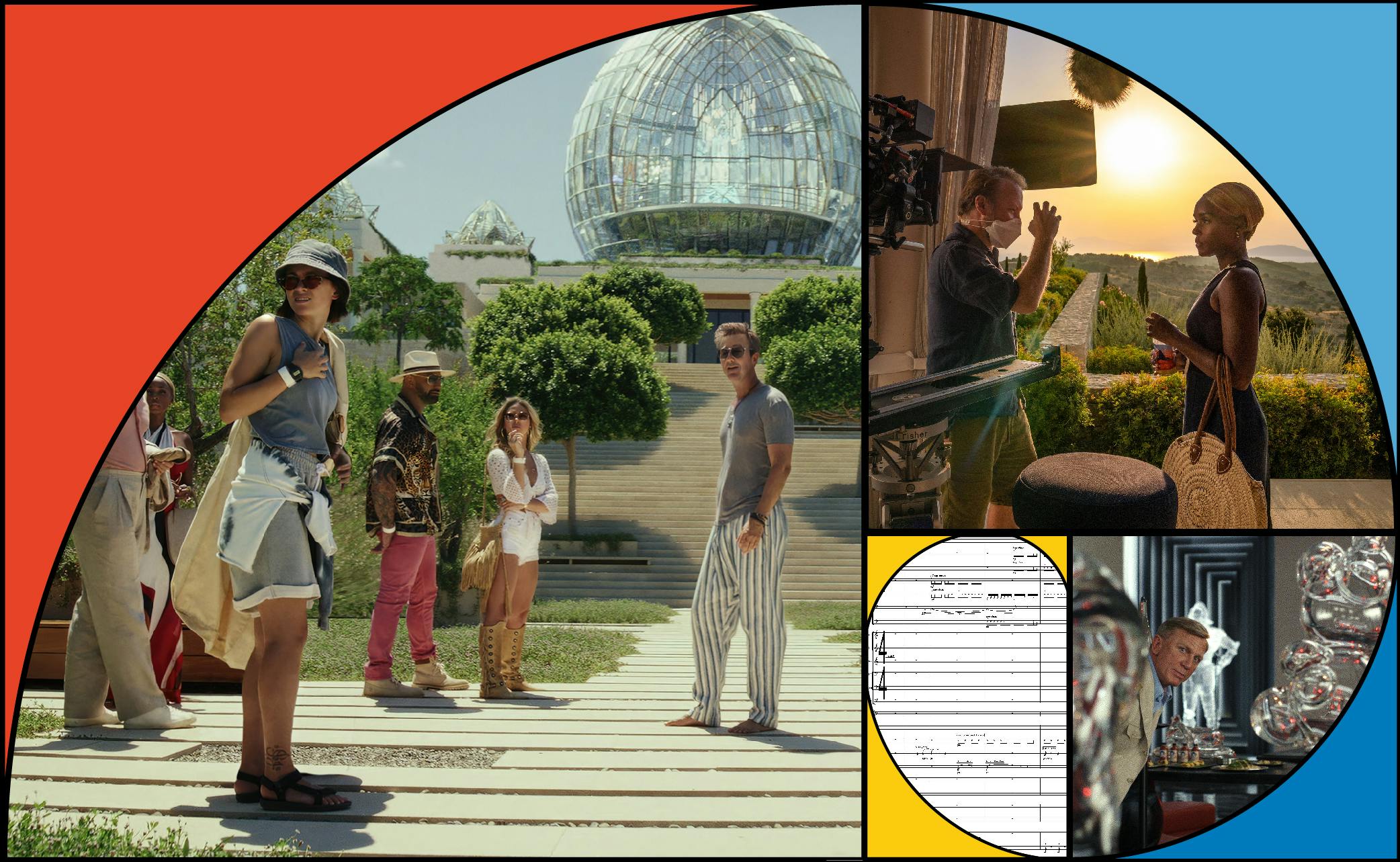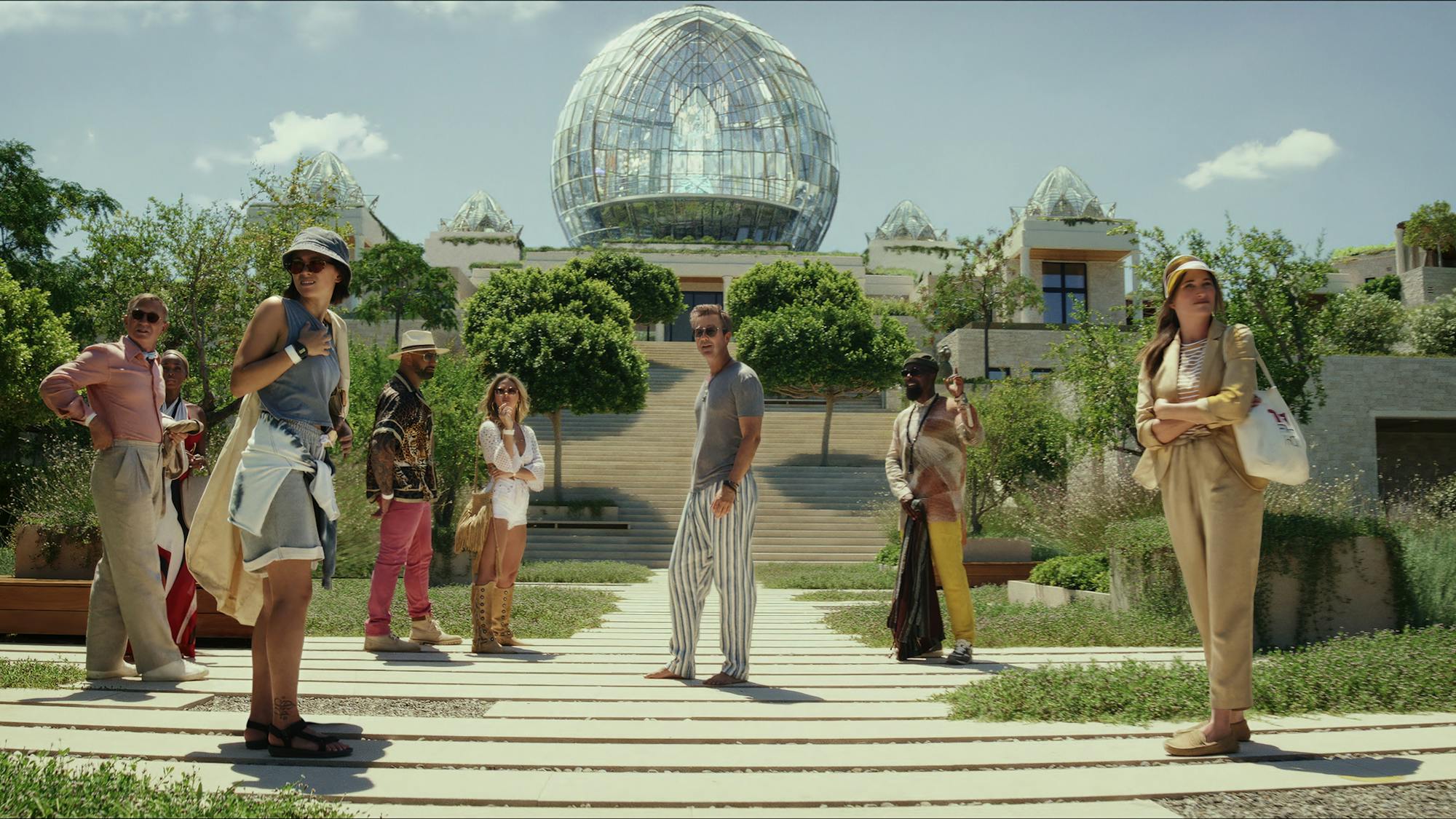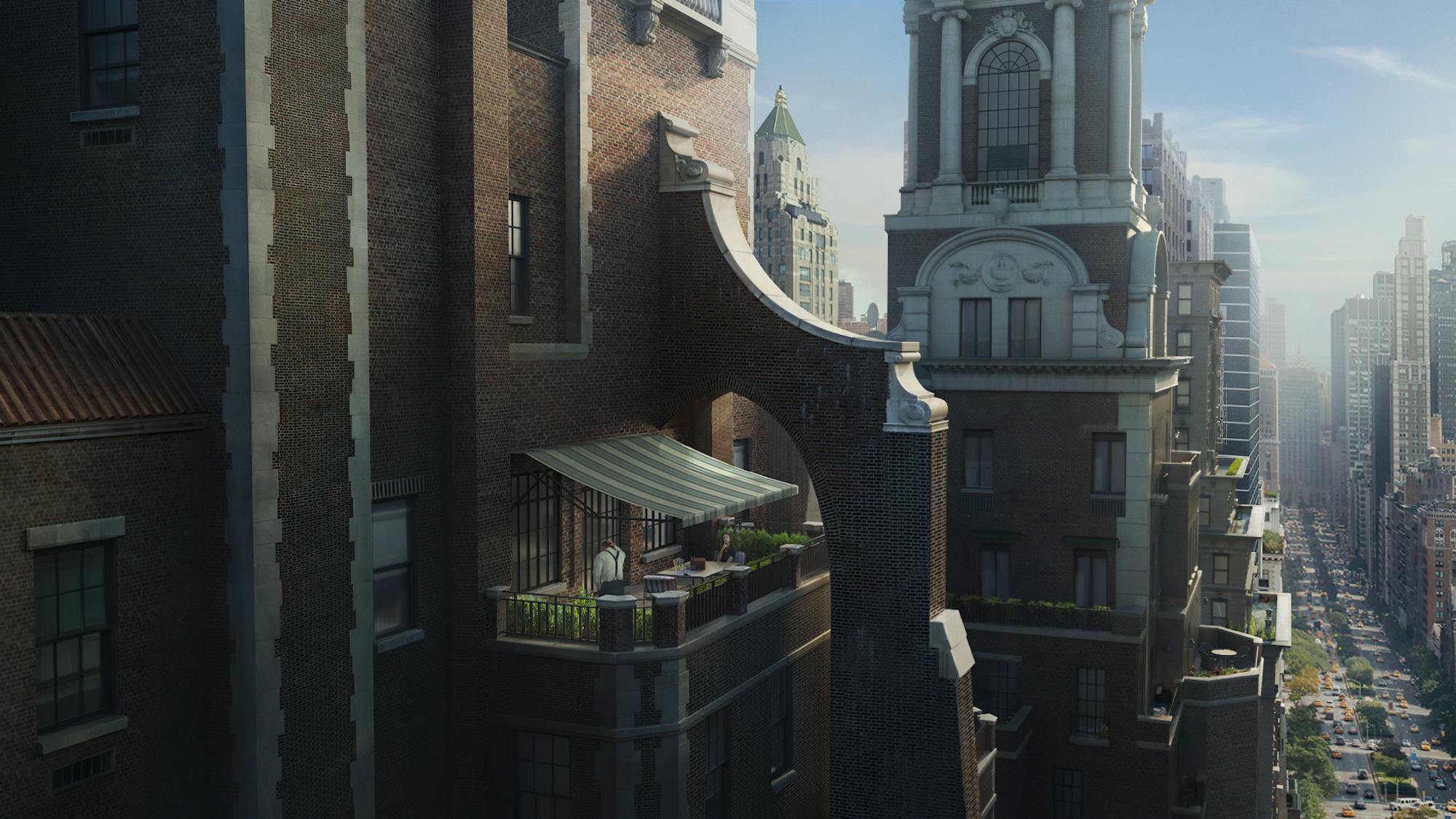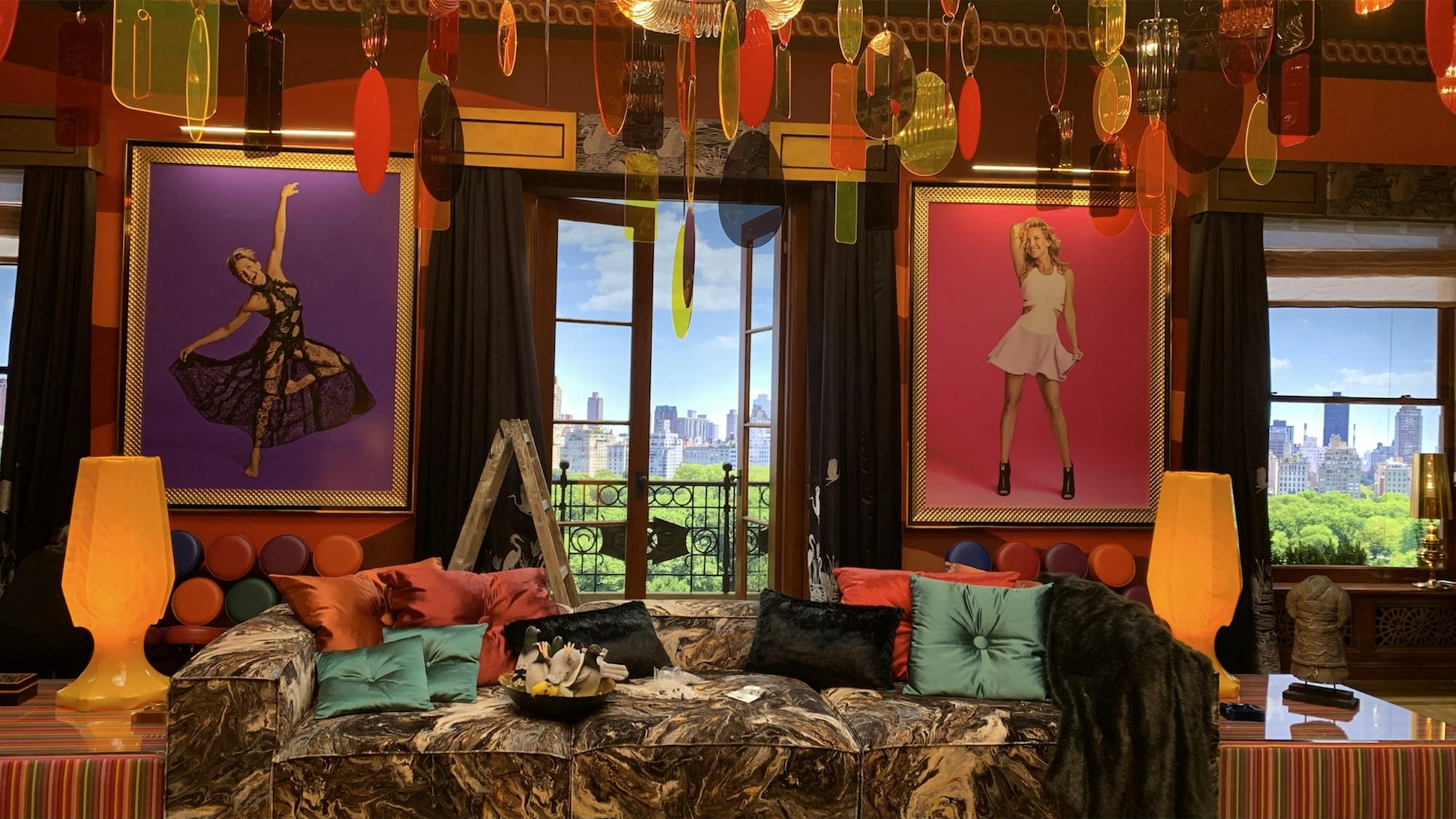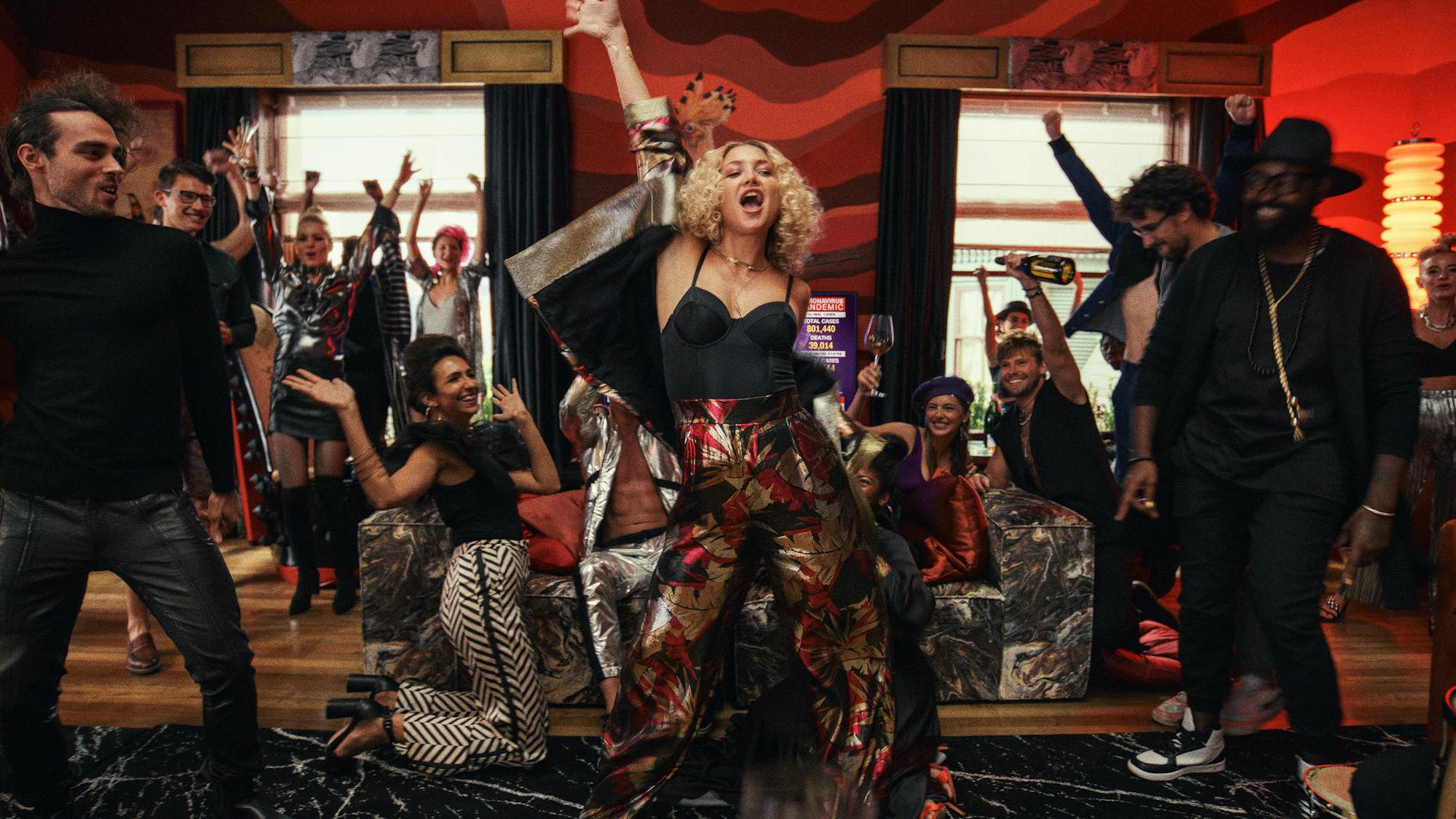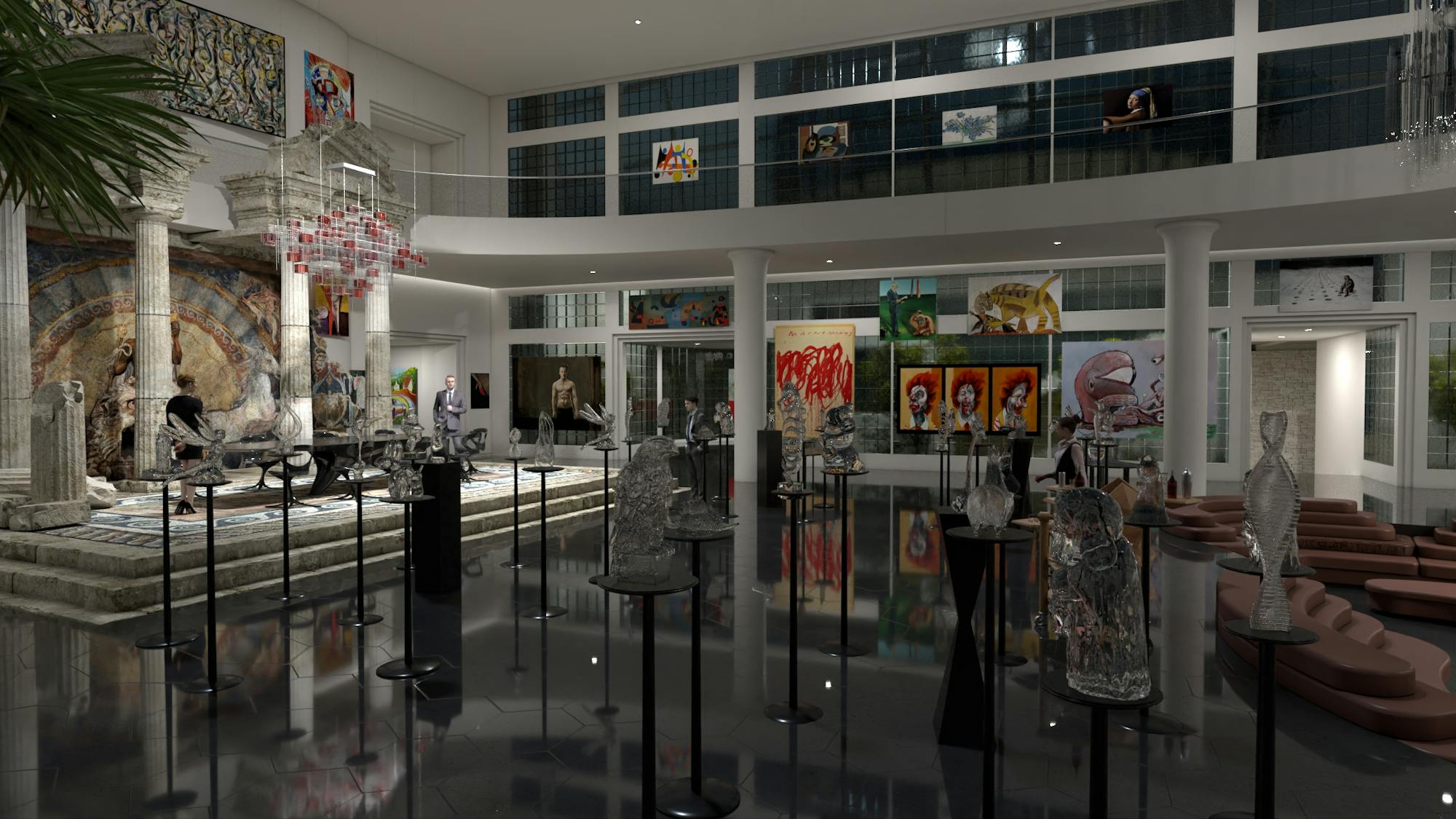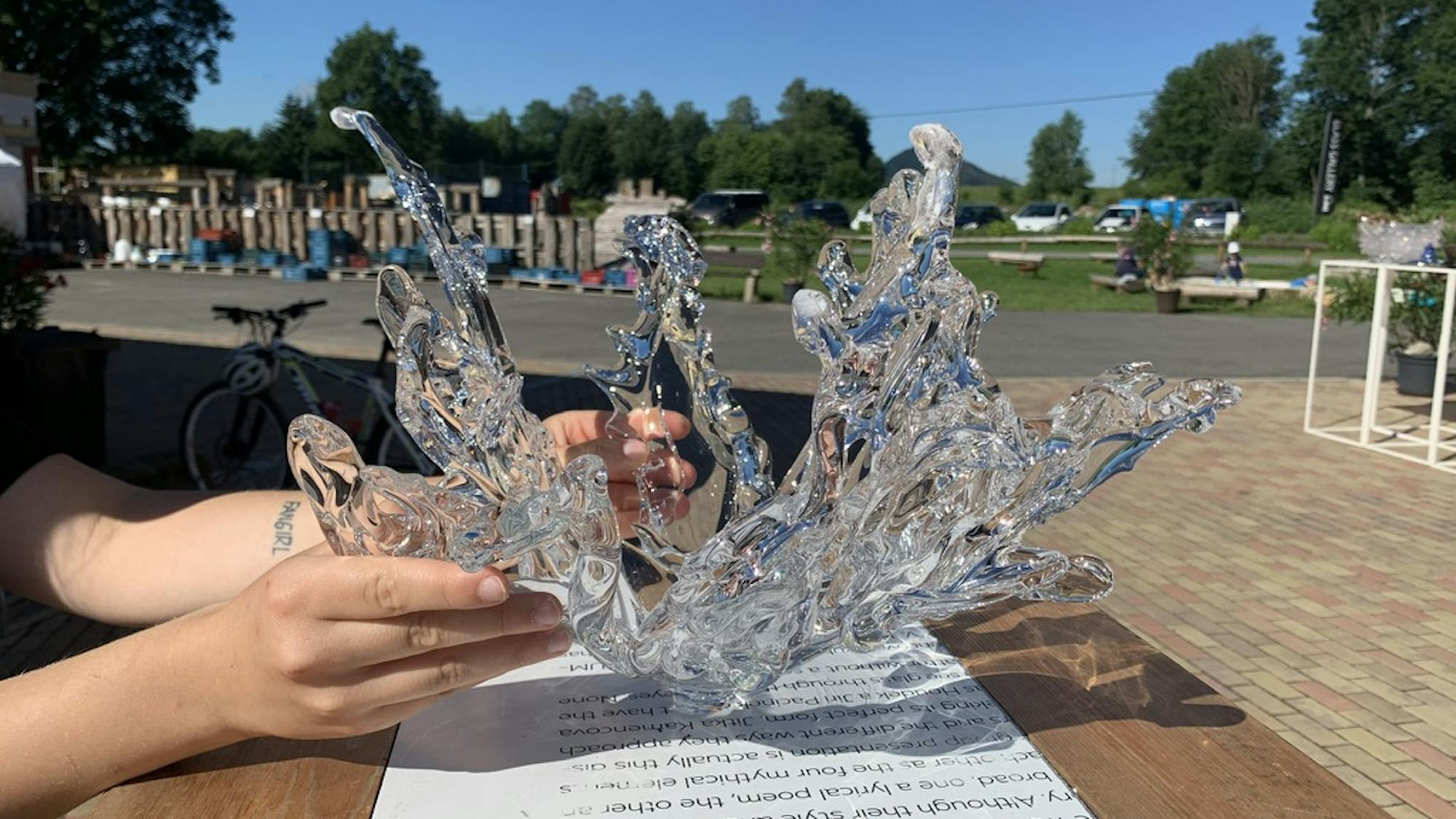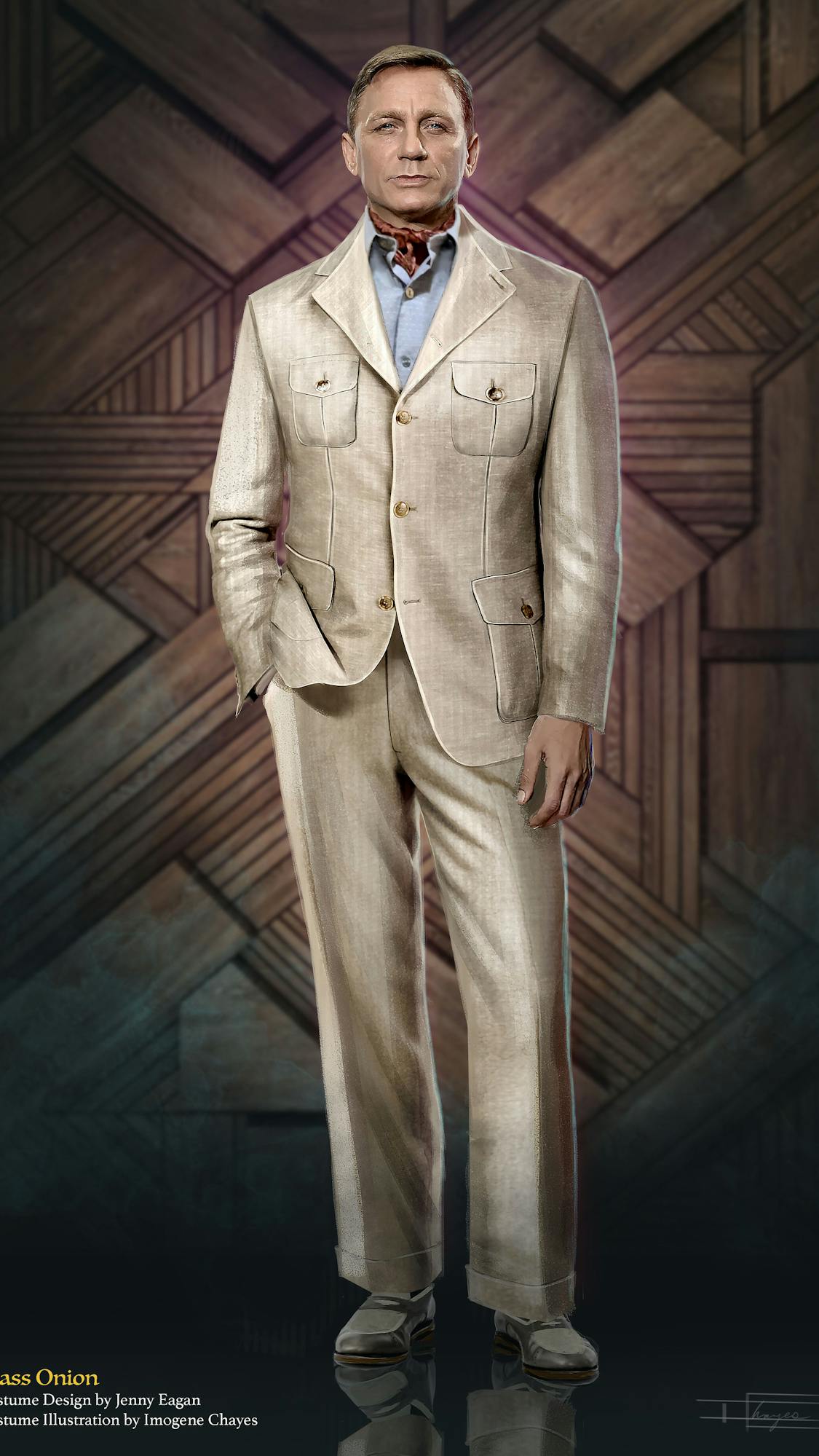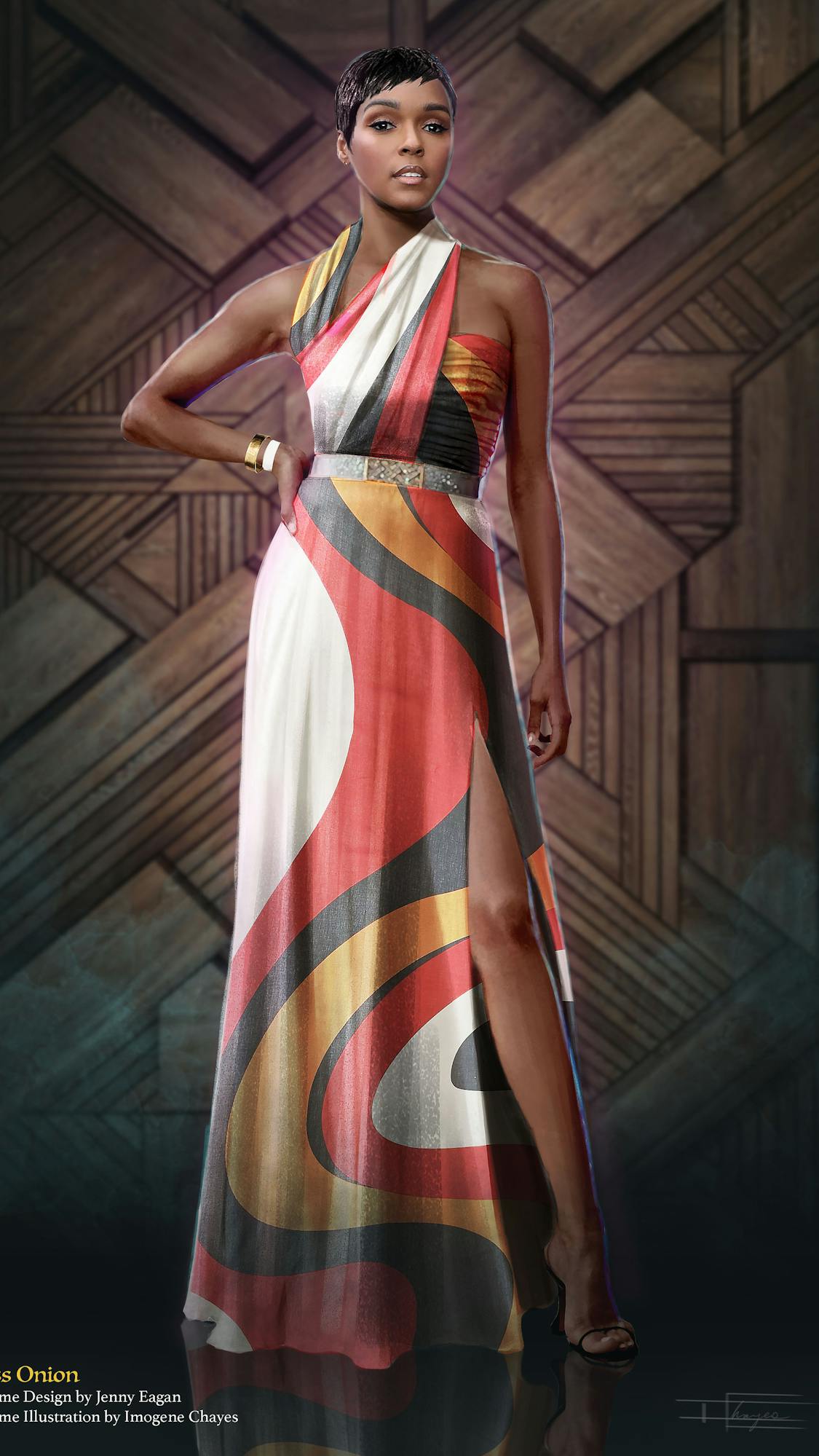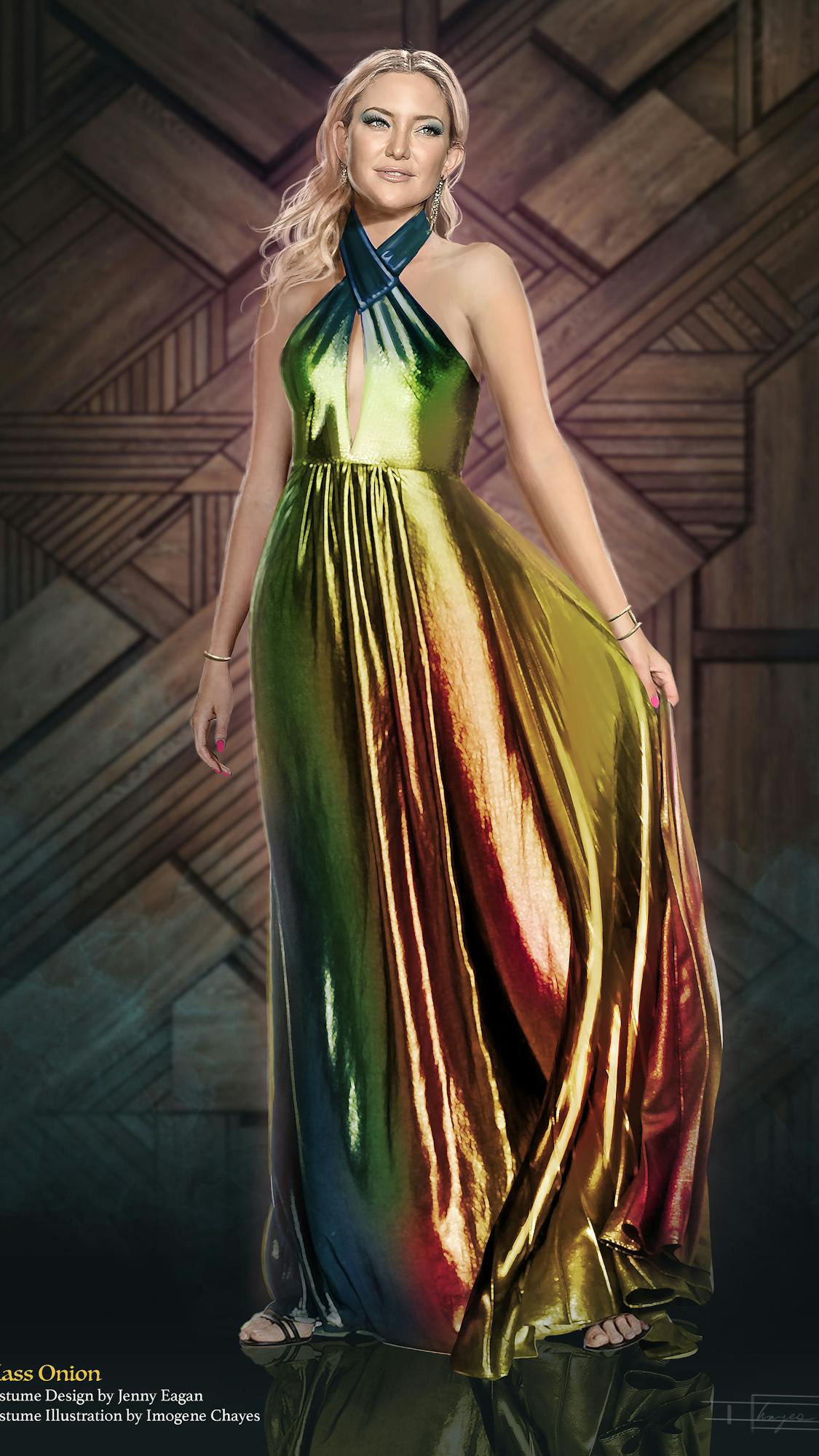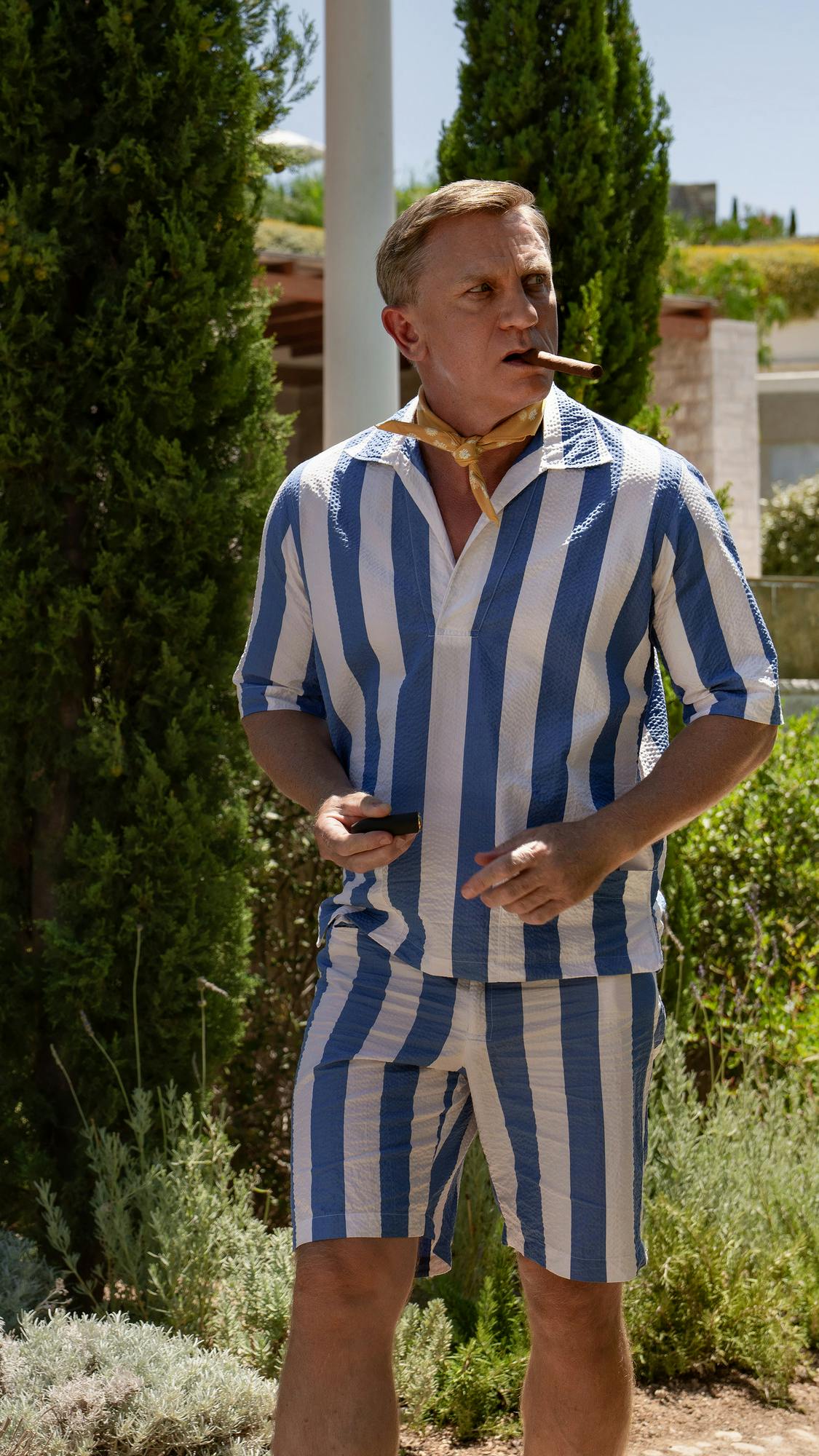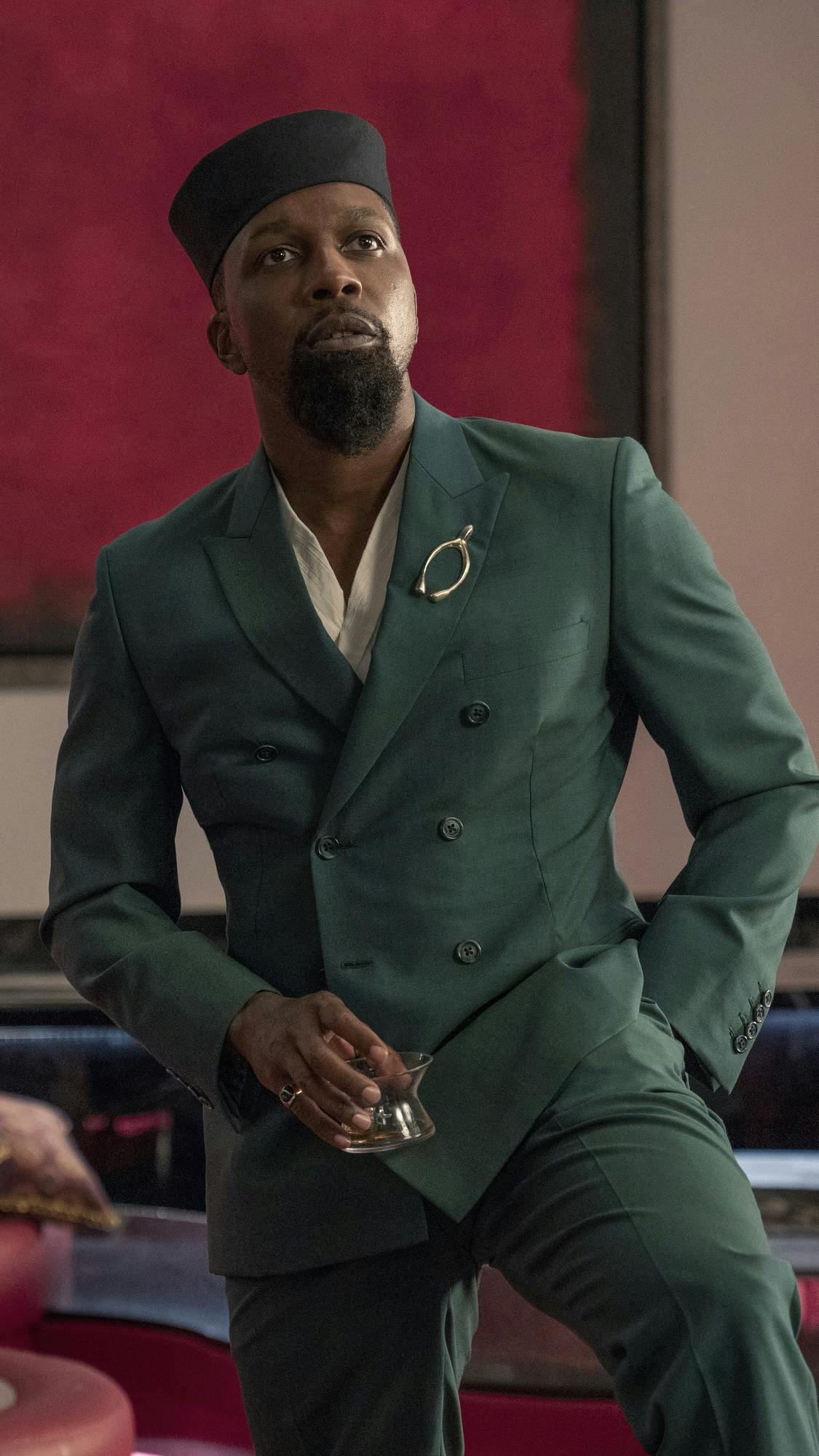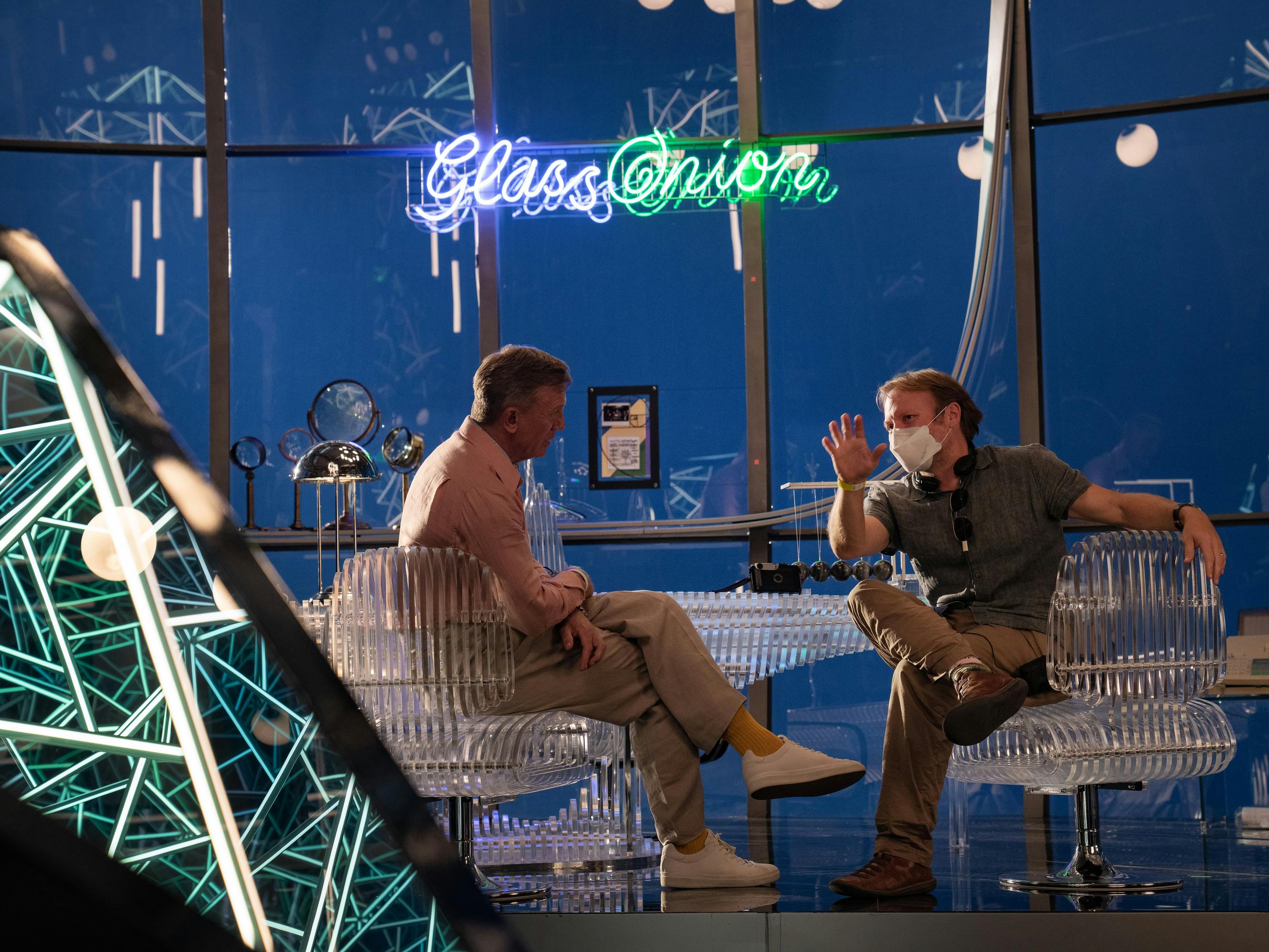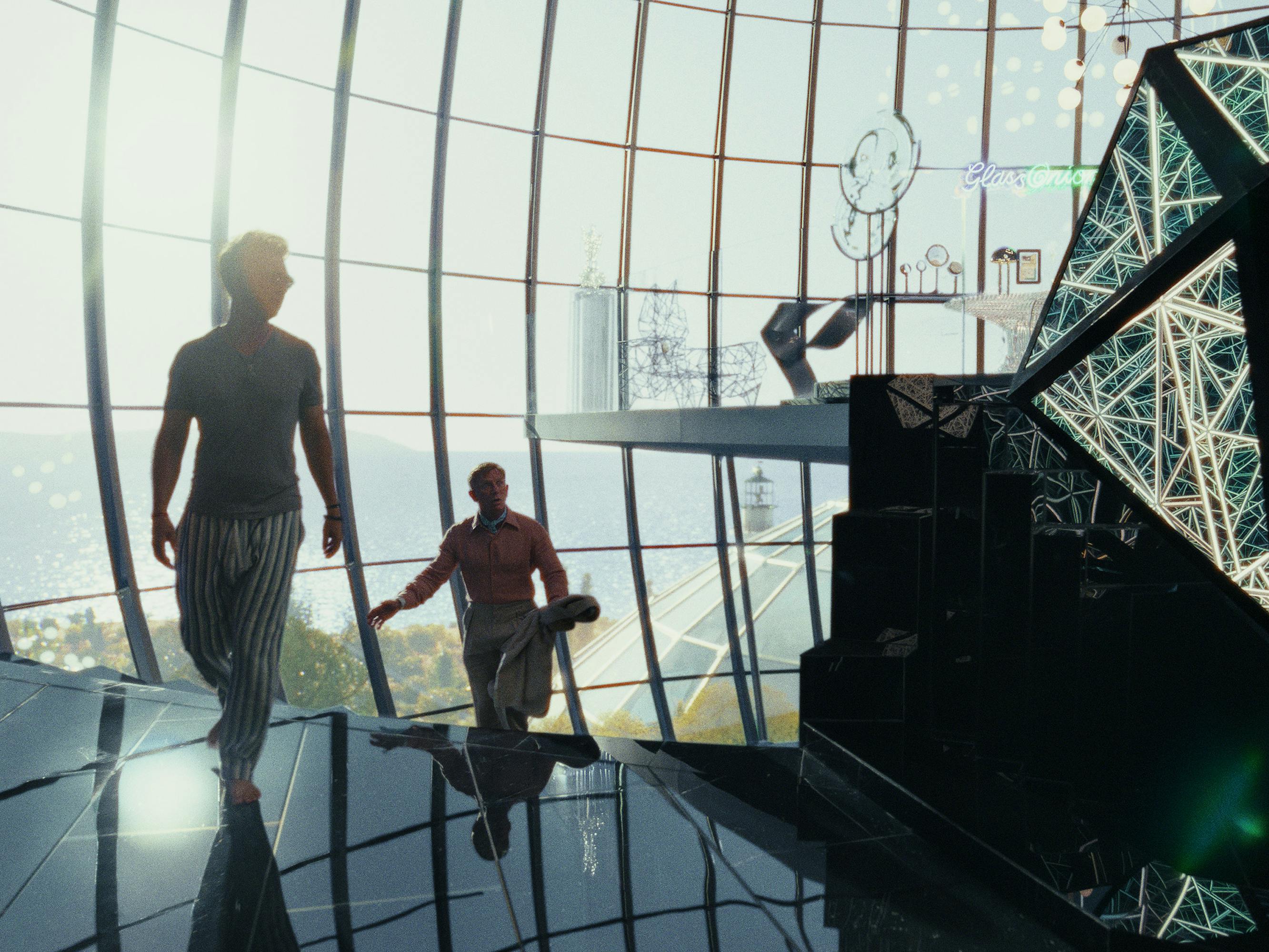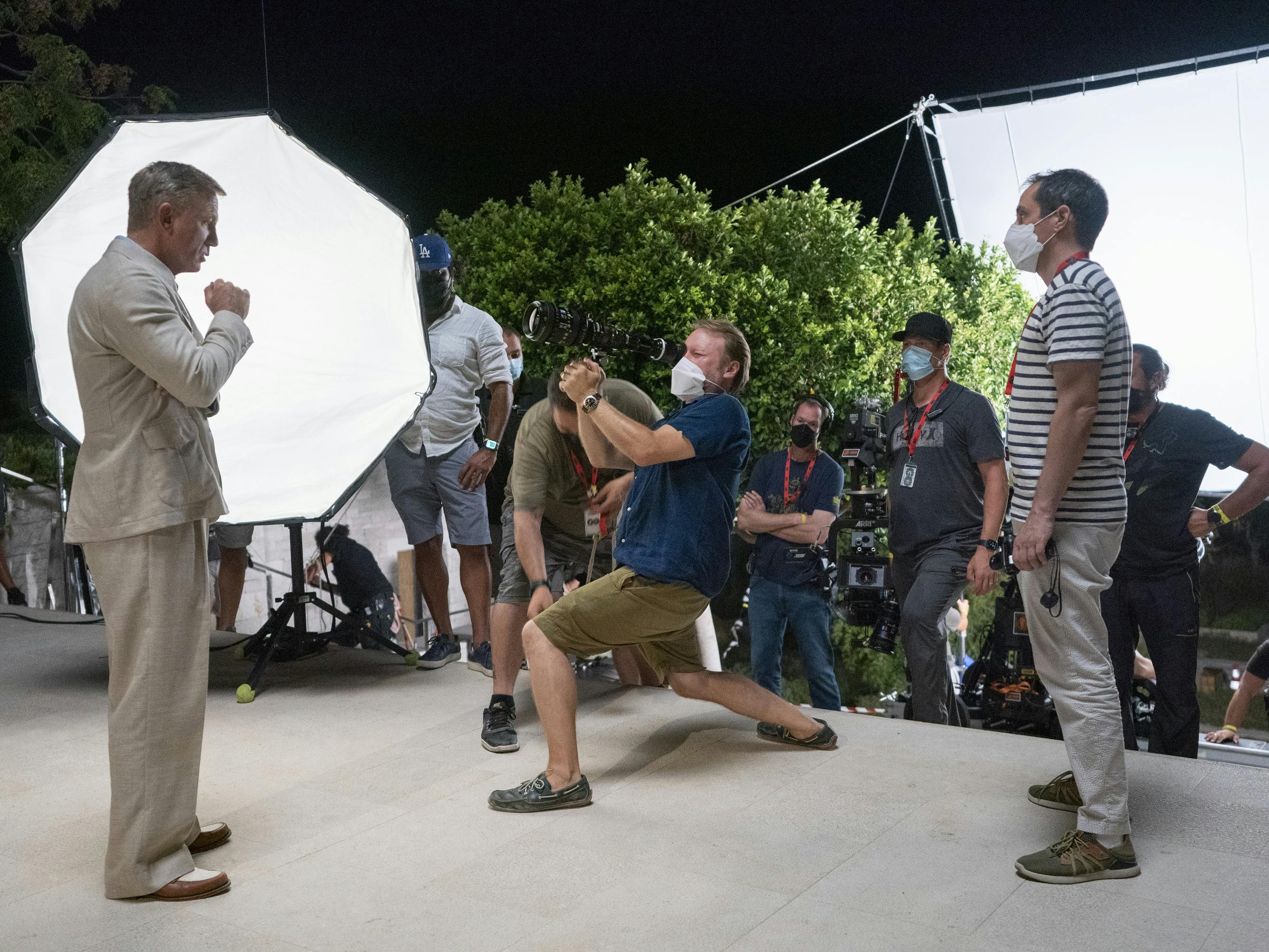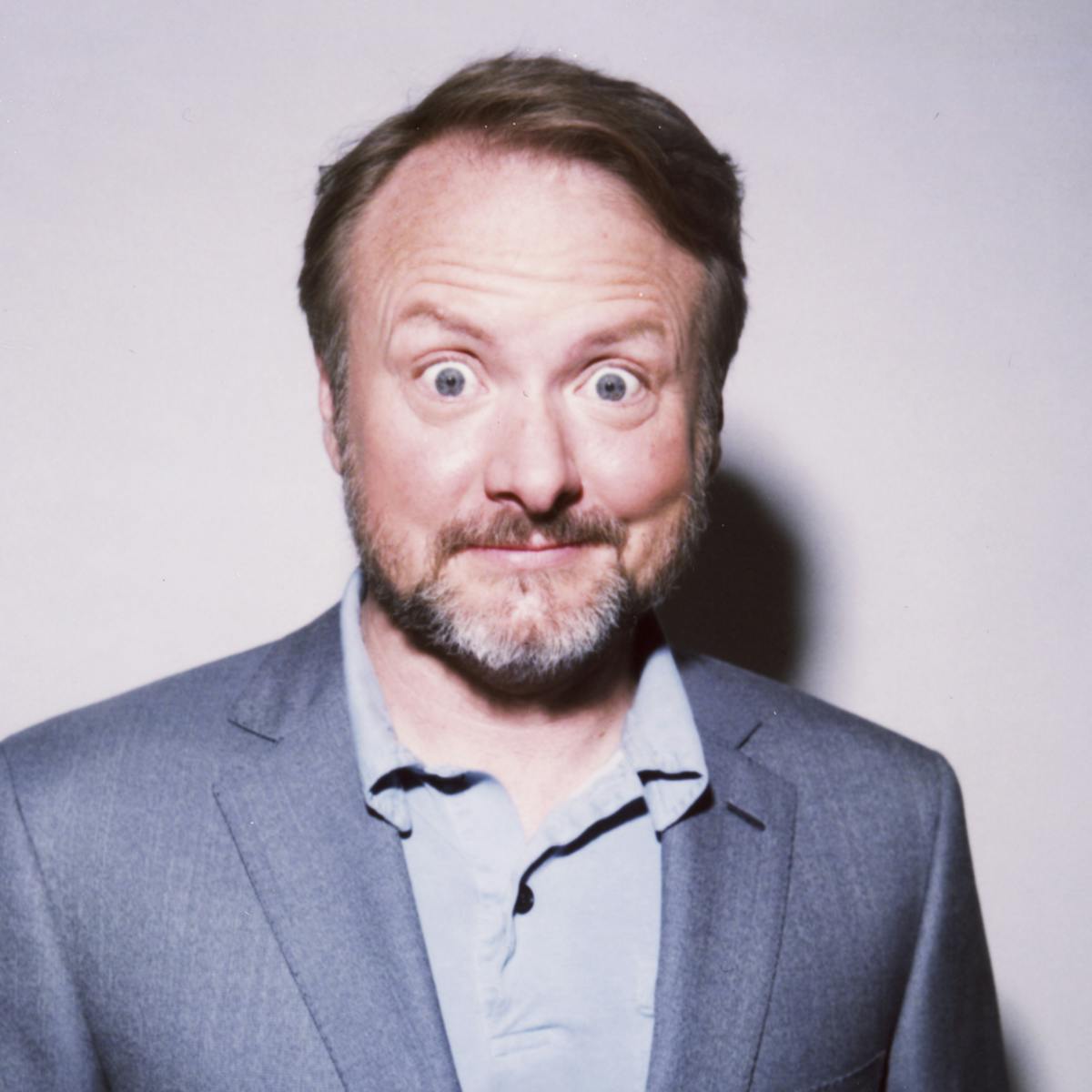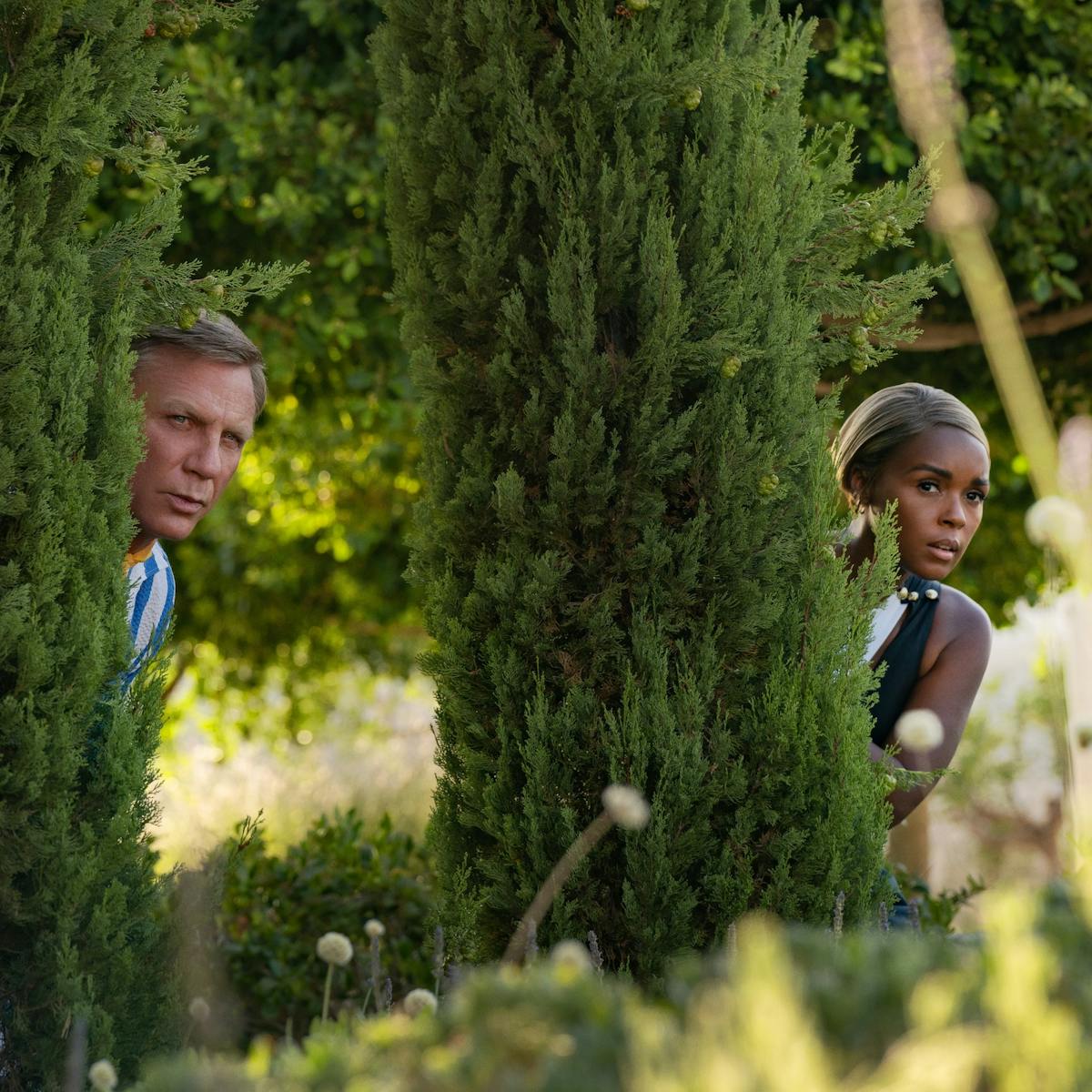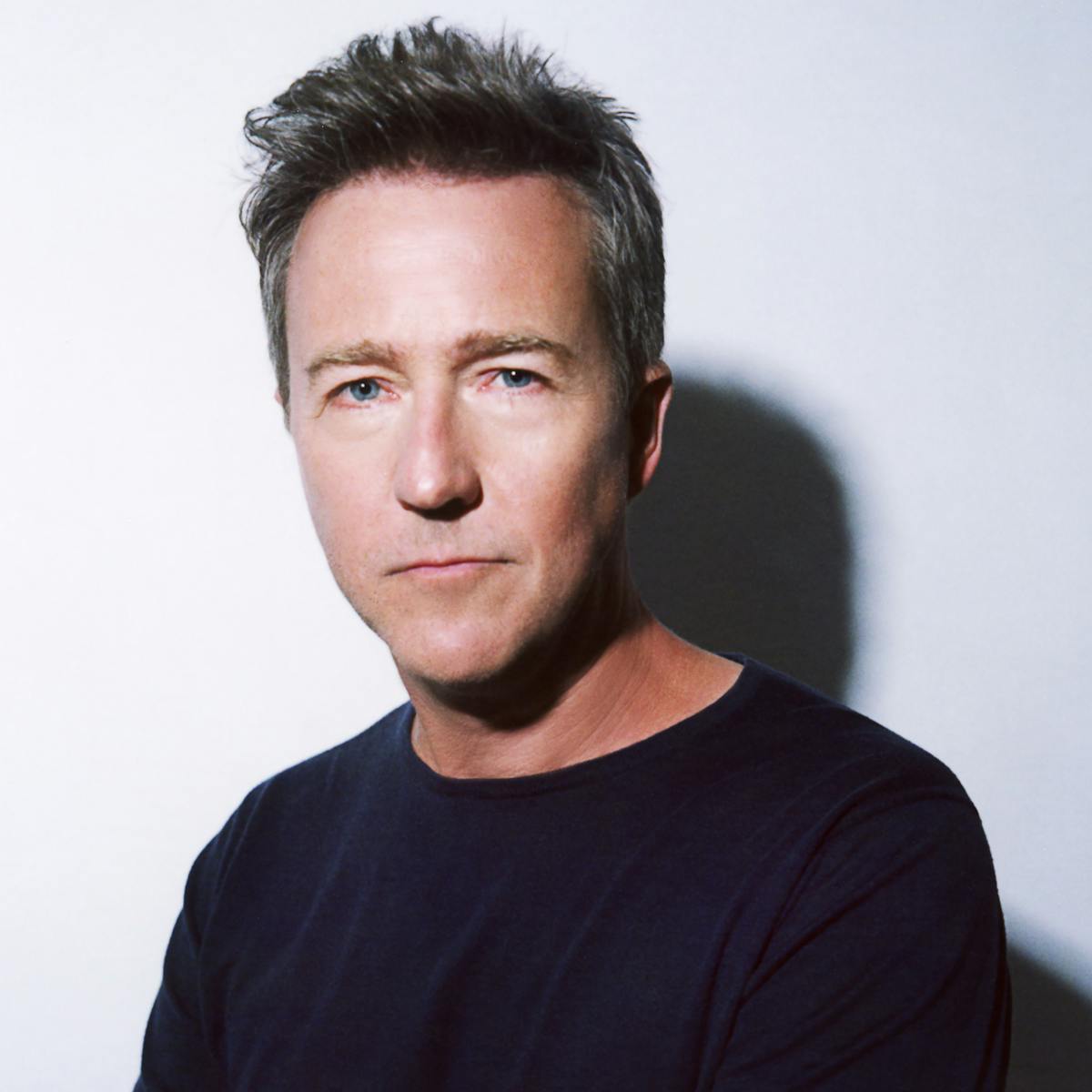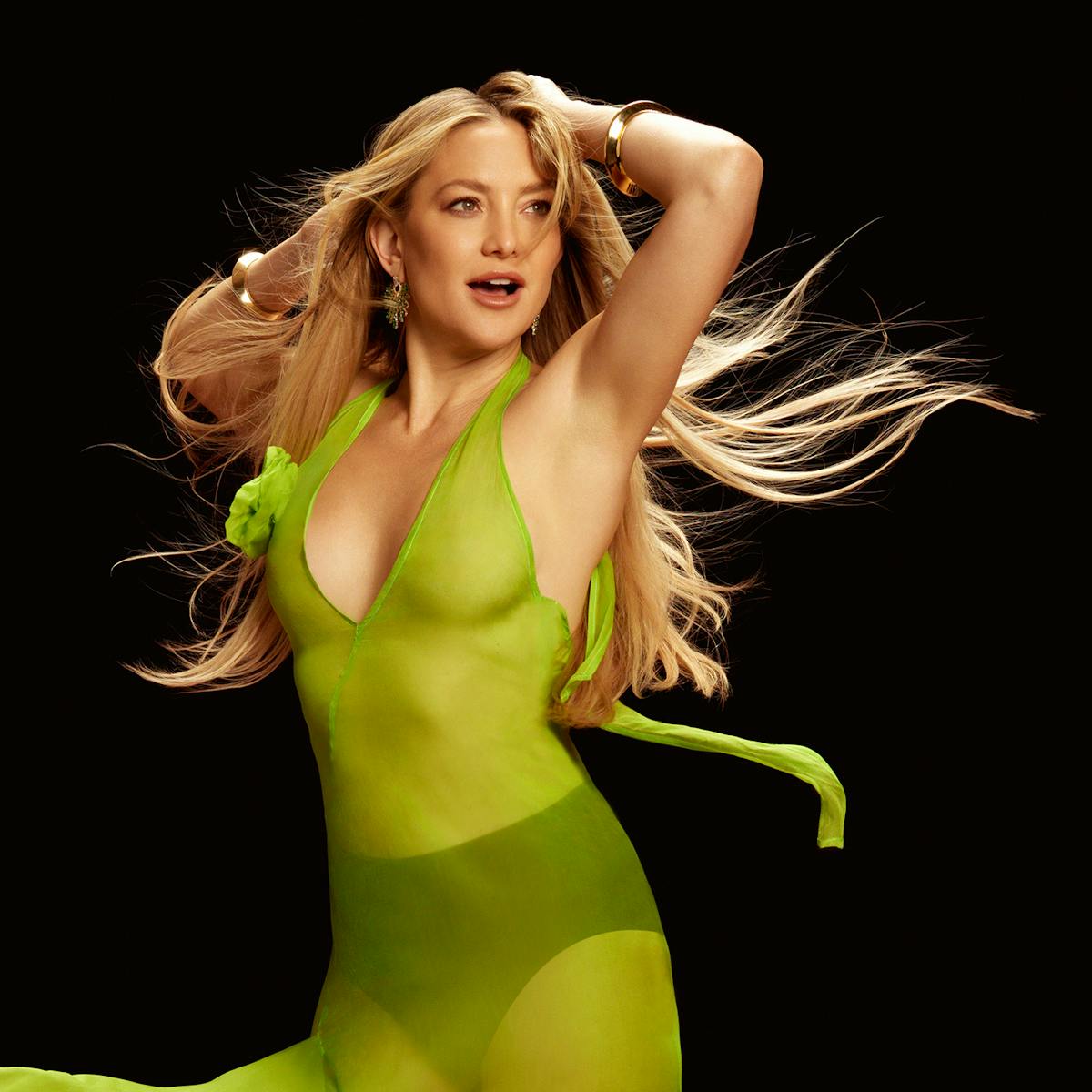When Rian Johnson set out to pen the sequel to his Oscar-nominated 2019 hit Knives Out, he began by envisioning a bigger, bolder mystery for his Southern sleuth Benoit Blanc (Daniel Craig) to solve. Rian was intrigued by the idea of a narrative in which the truth was hiding in plain sight. “I’m always fishing for something fun that Blanc can grab onto as an overwrought metaphor that he can beat to death,” says the writer-director. “The idea of glass came to me, something that’s clear. I literally searched my music library with the word ‘glass’ [and] the first thing that came up, because I’m a huge Beatles fan, was ‘Glass Onion.’ It was the perfect metaphor.”
The song made an ideal title for Rian’s second Blanc film, Glass Onion: A Knives Out Mystery, which sends the gentleman detective to a lavish private estate on a sun-dappled Greek island owned by tech bro billionaire Miles Bron (Edward Norton). The leader of an eclectic group of self-proclaimed “disruptors,” Bron has assembled his closest friends at his villa for a relaxing getaway as the COVID pandemic rages across the rest of the world; to entertain them, he’s designed an intriguing murder mystery game. But the frivolity comes to an abrupt conclusion when someone is actually offed, leaving Blanc to deduce the identity of the killer.
Thanks to its inventive premise and lively performances by an enviable ensemble of stars — with Craig and Norton joined by the likes of Janelle Monáe, Kathryn Hahn, Leslie Odom Jr., Jessica Henwick, Madelyn Cline, Kate Hudson, and Dave Bautista — the suspenseful yet satirical thrill ride has been a hit with both audiences and critics. The film’s success owes greatly to Rian’s timely and topical take on the whodunit genre, but also to the superlative cinematic artistry on display.
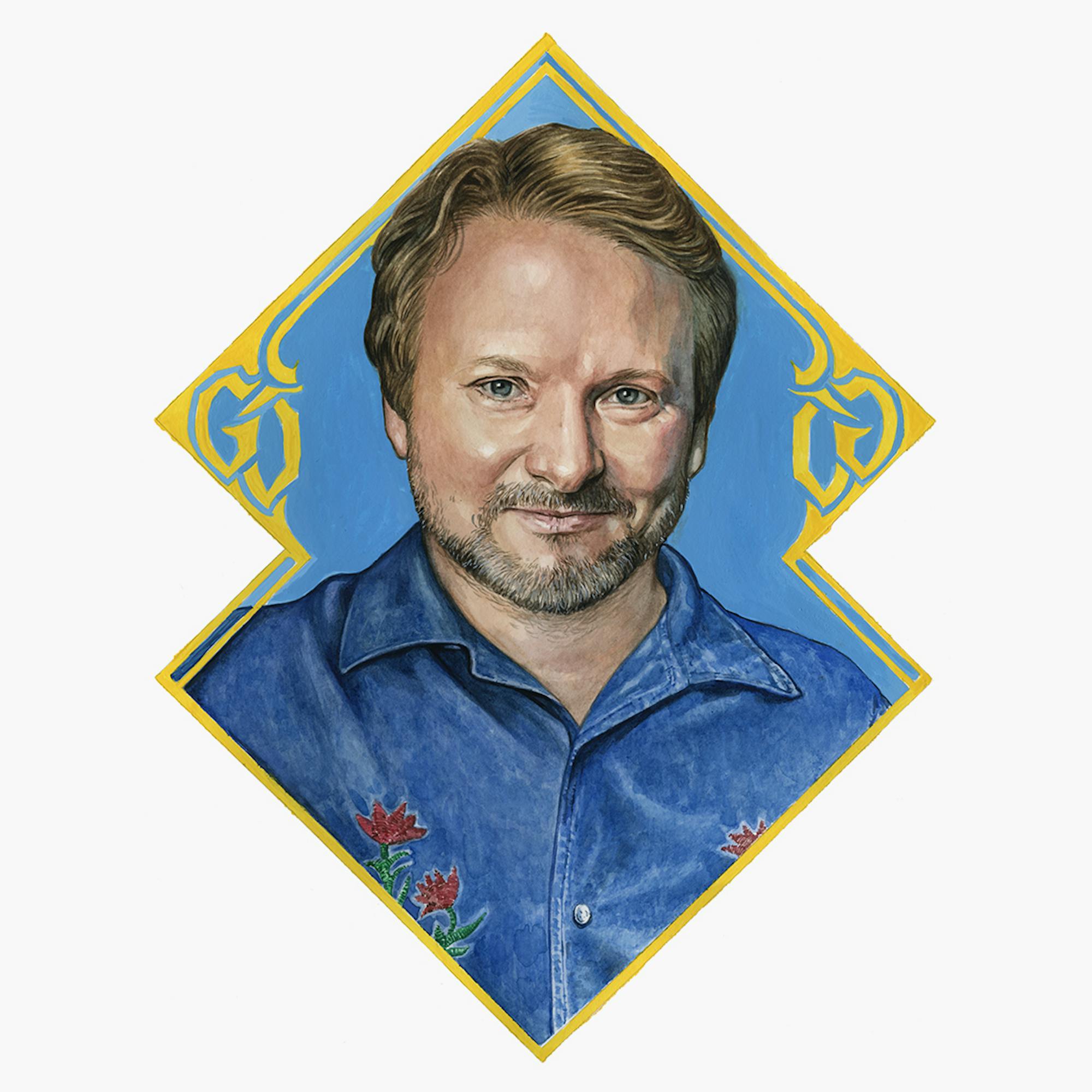
Writer, director, and producer Rian Johnson
To help him realize his vision for Glass Onion, Rian pulled together a top-flight crafts team, including Rick Heinrichs, Nathan Johnson, Jenny Eagan, Bob Ducsay, and Steve Yedlin, most of them veterans of the filmmaker’s earlier projects. Together, they rose to the challenges that the screenplay presented, not least of which was constructing the interior of the literal glass onion that sits atop Bron’s villa. “It really was a case of Rian pushing for something that was representative of Miles as a character,” explains production designer Heinrichs. “To me, it was like Miles’s big head, this inflated sense of himself.
“Rian is very collaborative,” Heinrichs continues. “I honor the fact that the director is not just helping us push the sets and the camera around. He’s the one who I actually can go to and bounce ideas off his own innate sense of what’s right and what isn’t right.”
To explore just how the team got it right, we’ve assembled a detailed roster of the creative collaborators who worked with Rian to unravel the mystery of translating the Glass Onion screenplay for the screen.
Bob Ducsay, ACE
Editor

Editor Bob Ducsay
Editor Ducsay knows exactly how to construct scenes and cut between suspicious glances to create the perfect level of suspense. From sneaky hallway shadow chases to an eerily empty hip holster, Rian’s longtime collaborator expertly builds tension — and, when called for, he understands how to play a moment for laughs.
From the desk of Rian Johnson:
“The delicate balancing of plot, story and especially tone always comes down to a thousand nuanced decisions in the edit room, and with a stew as complex as Glass Onion I feel very lucky to be working with Bob.”
Duscay's Rap Sheet
1. Glass Onion marks Ducsay’s fourth collaboration with Rian, having previously worked together on Looper, Star Wars: The Last Jedi, and Knives Out.
2. Ducsay loves mysteries. Aside from Blanc, of course, his favorite detective is Colombo.
3. Much like a detective, Ducsay operates on a combination of craft and intuition: “There are things that I do that come from experience, but there’s a huge part of what I do that is just from gut.”
4. Editing a mystery necessitates a delicate balance of guiding (or misguiding) the audience’s attention while pushing the story forward. Ducsay says, “You have to be entertaining; [as Rian has said] this is a roller coaster ride, not a crossword puzzle.”
5. Early on in the film, legendary cellist Yo-Yo Ma makes a cameo in which he explains a musical fugue. His short lesson in classical music contains an Easter egg that is reflected in Ducsay’s expertly crafted structure and the duality of Monaé’s characters, as pointed out by Vulture film critic Alison Willmore (and super fans on Twitter): “Johnson was attracted to the challenge of running through the same basic story twice, inspired by the compositional technique of a fugue, while keeping the viewer invested. ‘The audience absorbs Andi in one way and then you get this new piece of information that completely alters your understanding of her,’ Johnson says. ‘Helen pulls you in more.’”
6. Ducsay’s skillful pacing seamlessly draws us into the mystery of Glass Onion; the trick is making it all seem effortless. He shared with Variety: “That’s the most important thing I bring with me. You can add cuts for energy and style. But the reality of it is, if you can find the simplest way of constructing a moment or a scene with the fewest cuts that you can do, it’s extremely beautiful.”
Rick Heinrichs
Production Design
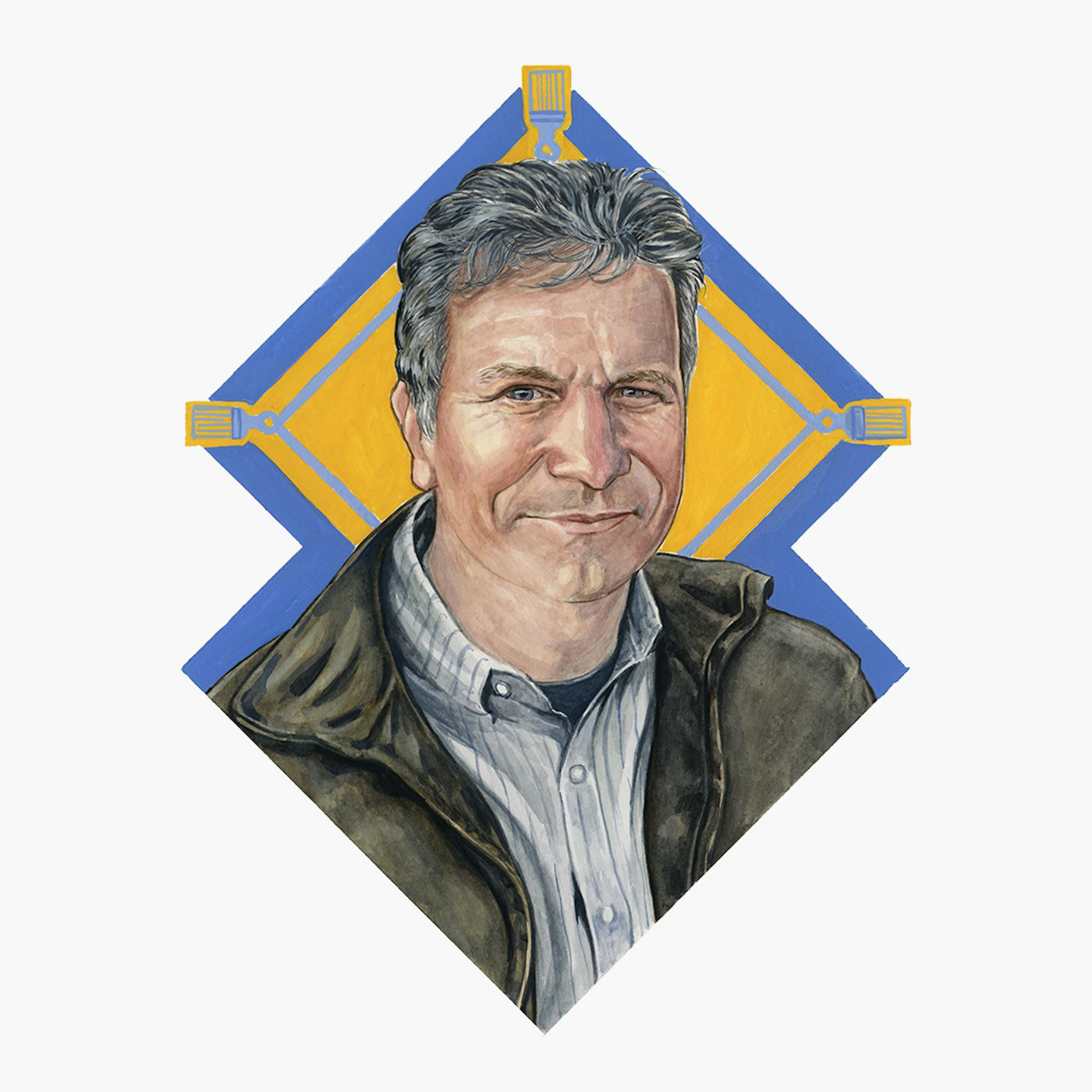
Production designer Rick Heinrichs
Heinrichs has crafted some of the most evocative and memorable cinematic worlds of the last 20 years. In Glass Onion, the Oscar-winning production designer balances a mastery of large sets with an attention to detail.
From the desk of Rian Johnson:
“Rick and I worked together on The Last Jedi, and I quickly learned that he is a genius at creating nuanced, thoughtful, character-based design on a massive, impressionistic scale. His sets are bigger than life but always sly and sharp, a tough task and the exact balance the film needed.”
Heinrichs' Rap Sheet
1. Heinrichs has earned Oscar nominations for his work on Pirates of the Caribbean: Dead Man’s Chest (2006), Lemony Snicket’s A Series of Unfortunate Events (2004), and Sleepy Hollow (1999), the last of which he won.
2. The elaborate invitation to Bron’s island is comprised of an eclectic mix of puzzles: a stereogram, a chessboard set up for Fool’s Mate, tic-tac-toe, a compass, a music box that plays Bach’s “Fugue in G Minor,” a Fibonacci sequence, and the number 47, the atomic number for silver.
3. The majority of the action in Glass Onion takes place in Bron’s lavish atrium, but Heinrichs also had to design each of the characters’ various homes for the scenes in which they’re introduced — from Blanc’s New York City bathtub to Duke Cody’s (Bautista) garage where he films his men’s rights influencer content.
4. Heinrichs drew on his past career as a sculptor to create the glass art objects that are featured throughout Bron’s atrium. To create the titular glass onion which sits atop Bron’s Mediterranean compound required 350 sheets of glass.
5. Monáe, who stars as Cassandra “Andi” Brand, described how well the production design complemented her arch nemesis Bron: “It was amazing how they were able to make Miles’s house match exactly who he is. It was like, ‘Oh my god, of course he would pick these specific paintings to have in his house.’ They killed it. The house in Greece was already just incredible on its own, but when we showed up we were just wowed.”
6. Cline, who plays Duke’s ambitious girlfriend Whiskey, was so in awe of the design she almost caused some damage: “I was so distracted at one point I put my arm in one of the glass sculptures and it got stuck. I just wanted to walk around and touch everything. I felt like I was a kid in a museum, just fascinated by the level of detail in all the pieces.”
Jenny Eagan
Costume Designer
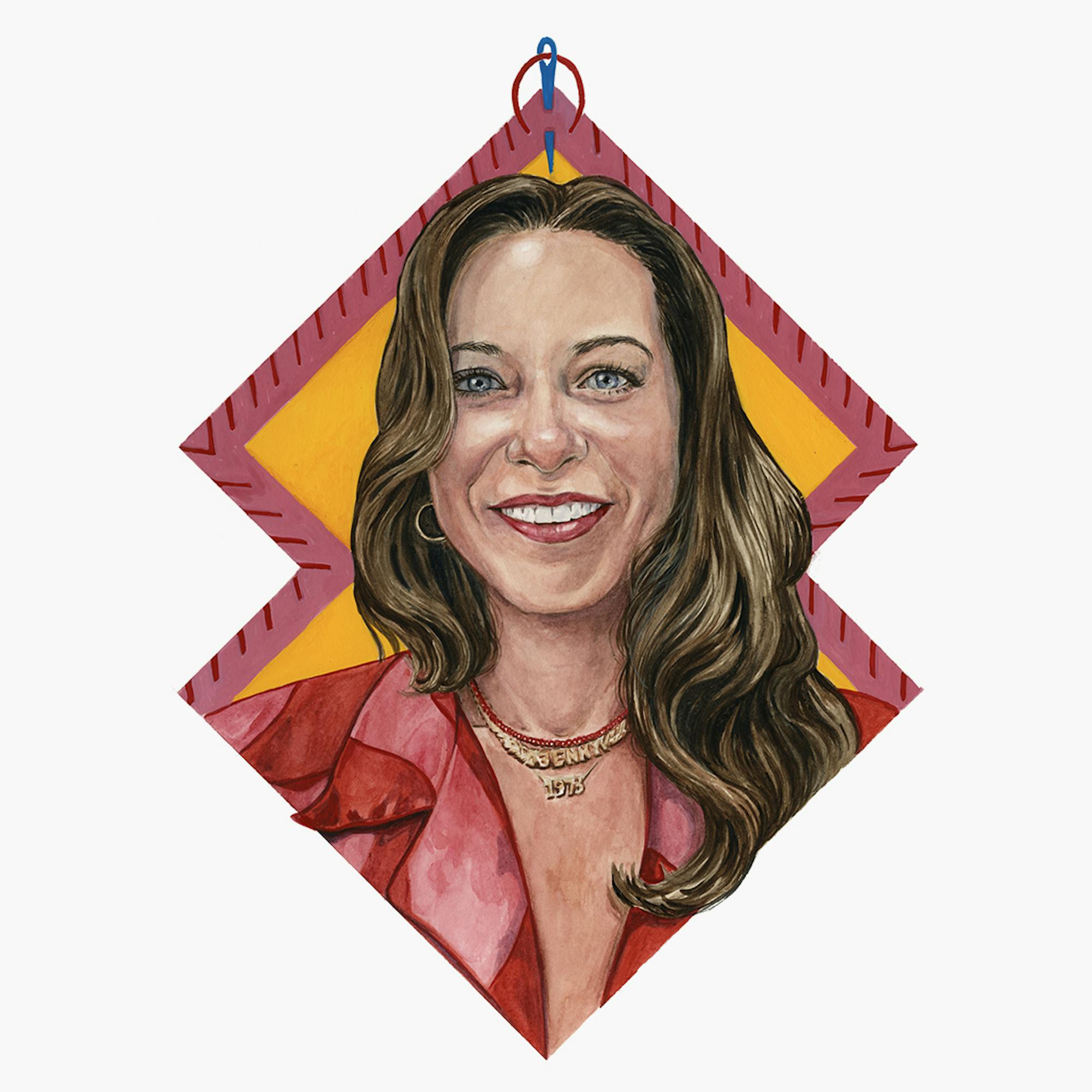
Costume designer Jenny Eagan
The scene-stealing cable-knit sweater of Knives Out was the brainchild of costume designer Eagan, who once again turns her wry sartorial eye toward a cast of eccentric characters in Glass Onion. For the second installment, the costume designer creates a new set of entertaining looks, proving wardrobe isn’t all spectacle; it’s storytelling.
From the desk of Rian Johnson
“Jenny is the not-so-secret weapon of these films. She collaborates with both me and the actors to create bold-stroke, unforgettable looks that start and end with character and that never lose a sense of effortless fun. Anyone who’s done it will tell you, that takes quite a lot of effort.”
Eagan's Rap Sheet
1. Eagan previously has also led costuming for Ryan Reynolds’s time-traveling 2022 film The Adam Project and 2020’s George Clooney starrer The Midnight Sky.
2. Eagan worked with Rian for the first time on 2019’s Knives Out, showcasing her ability to imbue each costume with meaning. Chris Evans’s fan-favorite chunky, egg-colored sweater, for example, was rife with symbolism. As the New Yorker reported, “When I spoke to Eagan recently, she told me that she chose to swaddle Evans in eggshell because it was the color of leisure, of a man who has never had to work a day in his life . . . The sweater has tiny holes at the sleeve and the neckline, a detail that Eagan said is purposeful — she wanted it to look like Ransom, who lives off his grandfather’s fortune, doesn’t care for his clothes.”
3. Designing a wardrobe to suit Monáe’s “rich bitch” tech-founder Brand required restraint and some foreshadowing. “There was something very calculated about Andi,” said Eagan. “So I wanted everything to have a bit of a geometrical kind of feel to it — it was like putting a puzzle piece together all the time. So everything of hers has either a square or there’s a lot of squares and circles — it’s all like puzzles for me.”
4. Eagan and Rian crafted Birdie Jay’s custom rainbow halter dress to be a hypnotic moment in the film: “Rian had the idea that the reveal would be her doing the twirl. It’s almost like an illusion or visual effect in and of itself when she does her spin, like the rainbow’s going in circles,” says Eagan.
5. Blanc’s poolside look needed to be chic and tailored, so Eagan had a two-piece look made from the same pattern used to create Frank Sinatra’s Palm Springs swimsuits. “I didn’t know what to do with [the swimsuit] because we knew he would wear a shirt. But what kind of shirt does Benoit Blanc wear? I just happened to be at a tailor that we work with, and his father used to make Frank Sinatra’s swimming pool outfits for him for Palm Springs. He said, ‘Oh, yeah, we still have the pattern.’ I saw this fabric that was so bold, and I was like, “Daniel, now we’re going to go for it.”
6. Eagan designed Odom Jr.’s Lionel Toussaint as the most stylish scientist. In his tailored green suit and hat, Lionel defies convention. “Just because you’re highly intelligent and studying all sorts of stuff doesn’t mean you can’t have style,” says Eagan.
Nathan Johnson
Composer
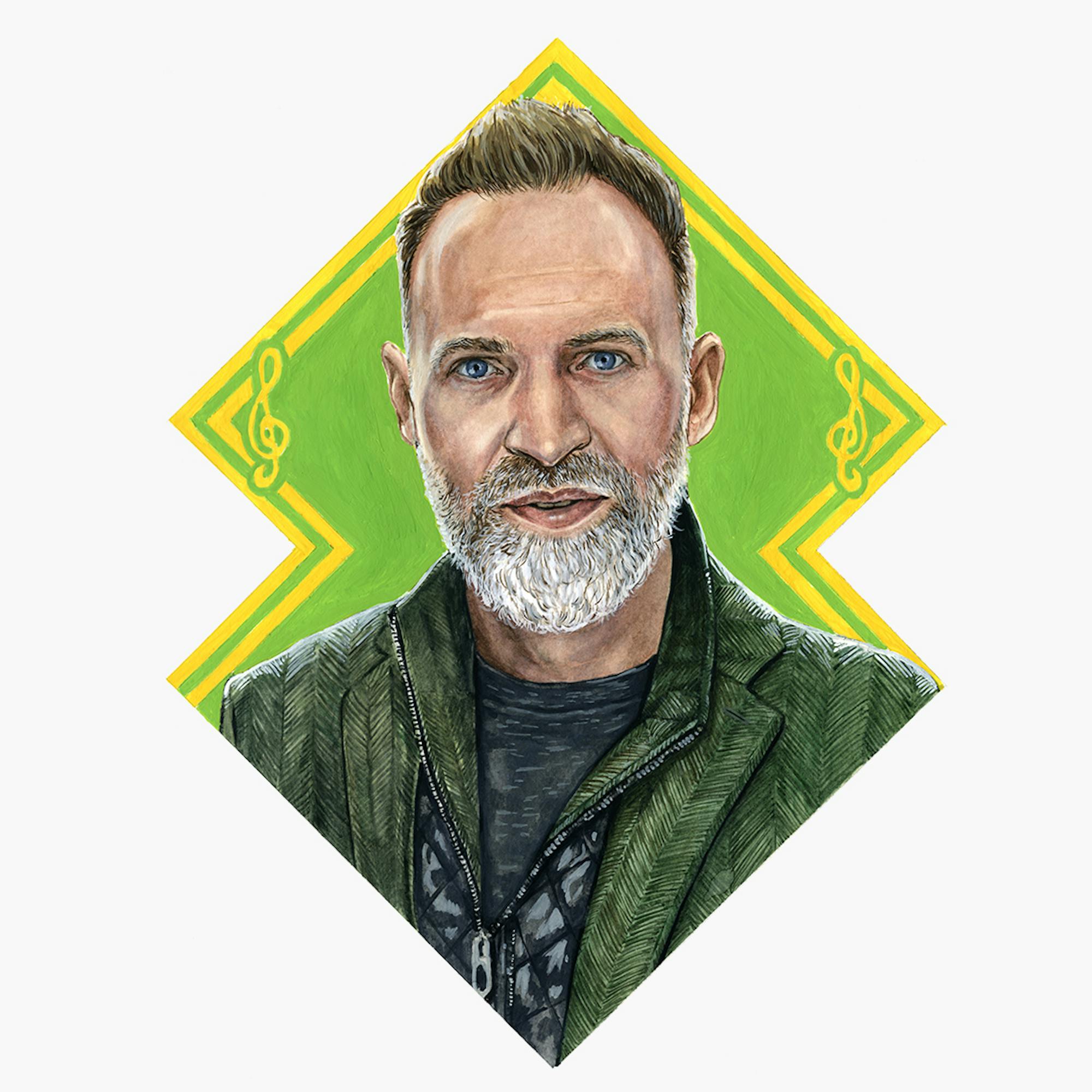
Composer Nathan Johnson
Nathan is Rian’s longest-standing collaborator: The cousins have worked together since they were kids. Nathan scored Brick (2005), The Brothers Bloom (2008), Looper (2008), and Knives Out under Rian’s direction. For Glass Onion, Nathan crafted an expansive and mysterious score.
From the desk of Rian Johnson:
“My cousin Nathan and I have been making movies together since we were 10 years old. He’s outdone himself with this one, a lush, grand, old-school movie-movie score that’s so much fun it’s easy to overlook the detailed, razor-sharp way he plays to the contours of each story moment.”
Johnson’s Rap Sheet
1. Nathan has been nominated for many awards, including a Critics Choice Award for his work on Guillermo del Toro’s Nightmare Alley (2021).
2. Nathan began the process of scoring Glass Onion by figuring out how to translate Blanc’s theme from Knives Out to the new setting.
3. Nathan aimed to reflect the film’s gamut of emotions with the title theme: “The title theme really encapsulates that bold, somewhat old-school feel of off-to-Europe! We need to feel that excitement that we’re gallivanting around the world, and at the same time, later in the movie, we need to feel the tension, we need to actually feel like there is danger for these people. We need to feel the connection to the characters, the sadness when a character we care about loses something, and then hopefully, by the end, we tie it all up and it’s almost like singing the chorus again when we hear that main theme.”
4. In addition to a title theme, Nathan designed melodic soundscapes for each member of the ensemble cast. For example, Monáe’s character Andi is often accompanied by a repeating arpeggio.
5. Nathan reached back even further than the first Knives Out into the past for inspiration for this installment, seeking inspiration in the grandness of old movies such as Death on the Nile (1978) with the Glass Onion score.
6. For the film’s score, Nathan led a 70-piece orchestra that recorded live, together in the same room for the first time since the pandemic. Of the scoring process for the latest Knives Out installment, Nathan shares: “We’re leaning into more of that 70s European string sound that I love. It feels magical, the orchestra sounds incredible, and we’ve got such an amazing group of players; it’s kind of like the best of all worlds coming together.”
Steve Yedlin, ASC
Cinematographer
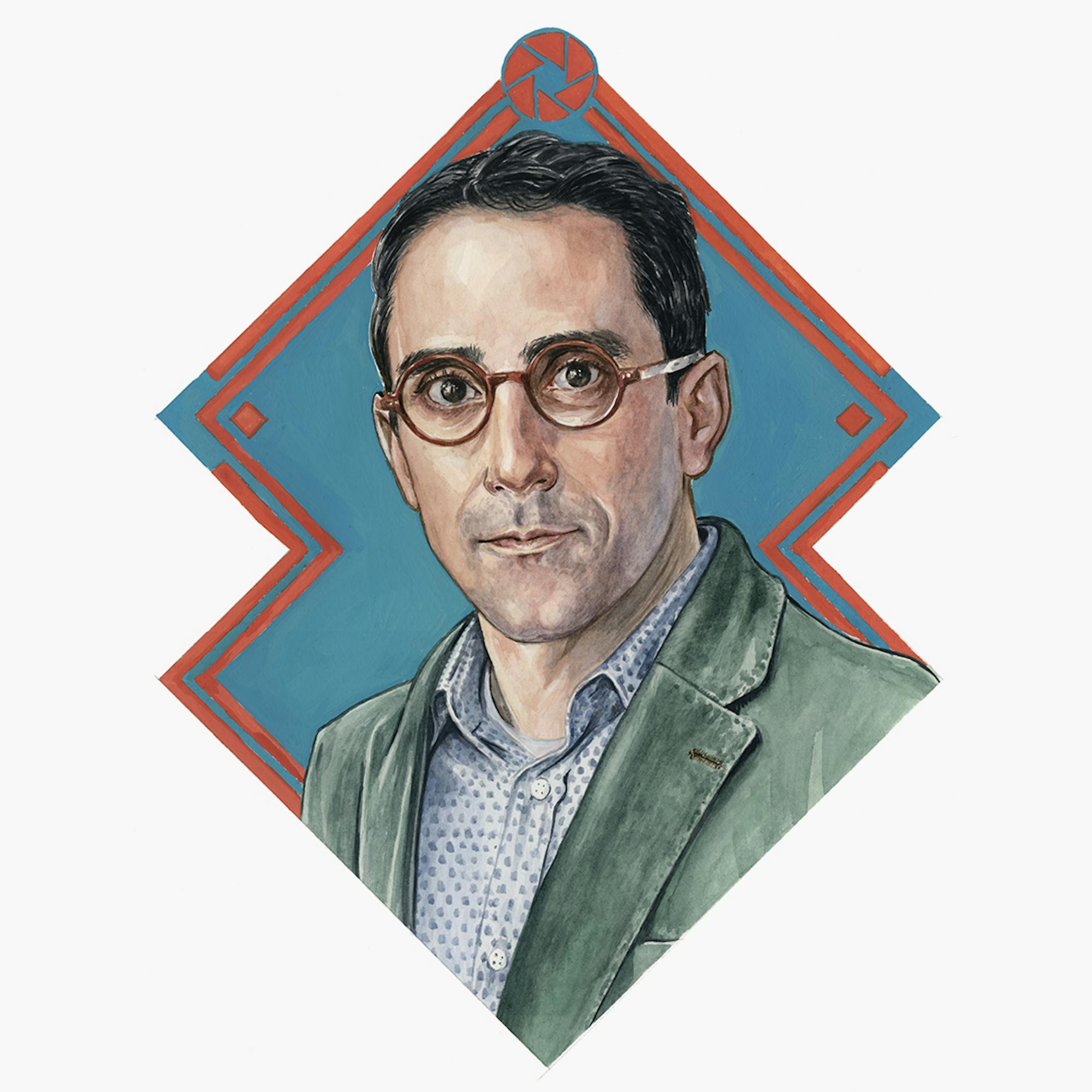
Cinematographer Steve Yedlin
From the high school noir of Brick onward, Yedlin and Rian have remained inseparable collaborators — most recently joining forces for Star Wars: The Last Jedi and Knives Out. For Glass Onion, the versatile cinematographer conjured a stunning cohesive visual world anchored by the over-the-top interiors of Bron’s opulent estate, and the memorable wardrobe of the ritzy cast of characters.
From the desk of Rian Johnson:
“I’ve worked with Steve on all my films and have felt very lucky to grow alongside him. His work starts with a story, and in that way, he’s a true collaborator, from visual ideas behind the first inkling of a script idea to the final day in color correction.”
Yedlin’s Rap Sheet:
1. Yedlin has known Rian since they were teenagers. The first short film they worked on — “a silly little chase scene” — was called, Hey Lady, You Dropped Your Wallet.
2. Yedlin racked up early cinematography credits on indie horror films including May (2002) and Toolbox Murders (2004) prior to teaming with Rian for the first time on Brick. Apart from shooting Rian’s films, he’s also served as director of photography on such features as Girl Most Likely (2012), Carrie (2013), Danny Collins (2015), and San Andreas (2015), among others.
3. While some director-cinematographer collaborators have specific visual motifs or signatures, Rian and Yedlin always let the world of the film dictate its visual language. Yedlin explains, “We don’t have to say, ‘Hey, let’s do a different style this time.’” Glass Onion, for example, was “automatically going to have a different style because of the fact that it’s [set in] sun-baked Greece, and not overcast, wintry, New England.”
4. “We always see shot design, and lighting, and everything as just what’s the visually best way to tell this story,” Yedlin describes of the visual balance. “The visuals can’t be doing their own thing to say, ‘Hey, look at me over here, and grab attention away from the story.’ But that also doesn’t mean blandly overlighting so you can see everything. It means really [determining] what’s the visually most exciting way to underscore what’s going on.”
5. While the exterior view of Miles’s Glass Onion office is V.F.X., the interior is “a real set,” Yedlin says. “It’s just not a set that’s on the roof of a building in Greece.” That meant that the space had to be properly illuminated for scenes during bright sunny days or clear nights. “We really lit it with a big light on a crane to replicate the sun sweeping in there,” Yedlin says. For the nighttime look, the filmmakers employed faceted glass. “We talked with the art department and production design about those chandeliers, and really having something that when you see reflections of it, and it is multiplied, it feels like a big field of stars.”
6. Among other logistical challenges, the lighthouse effect used in select scenes proved a puzzle, says Yedlin: “We wanted to have really, really sharp shadows. Rian had said he had basically zero interest in it being realistic; he wanted it to be highly theatrical, like a really sharp sweep on and sweep off.” Through a series of trial and error with timing mechanisms, lamp heads, remote controls, and motors, they achieved the desired effect. “It really felt like doing an old-school film noir,” Yedlin says.
